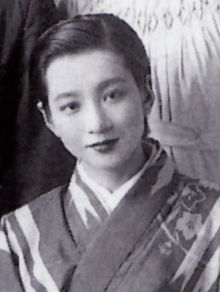Keiko Sonoi | |
|---|---|
園井恵子 | |
 Sonoi in her Takarazuka days | |
| Pronunciation | Sono'i Kei'ko |
| Born | Tomi Hakamada (袴田トミ) August 6, 1913 Matsuo, Iwate (now Hachimantai) |
| Died | 21 August 1945 (aged 32) Kobe, Hyogo |
| Nationality | Japanese |
| Other names | Kiyono Kasanui (笠縫清乃)[1] |
| Alma mater | Takarazuka Revue |
| Occupation | actress |
| Years active | 1930–1945 |
| Known for | film, theatre |
| Notable credit | Muhōmatsu no isshō (1943, Daiei Film) |
| Height | 155 cm (5.09 ft) |
Keiko Sonoi (園井 恵子, Sonoi Keiko, 6 August 1913 – 21 August 1945) was a Japanese actress, who was a member of the all-female musical-performing Takarazuka Revue during the 1930s and the 1940s, best known for her role as an officer's widow in the wartime film Muhōmatsu no isshō (1943), and for being part of the Sakura-tai or Cherry Blossom Unit of traveling shingeki play actors who died as a result of the 1945 Hiroshima bombing.
The fate of the Cherry Blossom Unit was later dramatized by playwright Hisashi Inoue, and also made into a feature film by director Kaneto Shindo.
The actress appears to have had a long-held desire to perform shingeki plays, but that was not economically viable due to the need to her support her parents and siblings. As a Takarazienne, she had the manga comic artist Osamu Tezuka as a childhood fan who lived on her block, and Astro Boy may have been influenced by Sonoi's performance of Pinochio ("Pinocchio") from April to May, 1942.